Are your cold emails landing in spam?
Email warmup could be the fix.
Email warmup involves gradually increasing your email sending volume to build up a solid sender reputation and improve your inbox placement.
By the end of this post, you’ll know exactly how to warm up your email domain the right way—so your emails avoid the spam folder and get the engagement they deserve.
What is email warmup?
By slowly increasing sending volume and frequency and getting engagement (opens, replies), you establish a sender reputation with internet service providers.
Once they know and trust you as a legitimate sender, they’ll allow more of your emails to reach the inbox.
Email warmup (also known as IP warming) is not just about email volume. It’s also about:
- Frequency (how often you send email)
- Engagement (how recipients interact with your emails)
It’s important to note that sending domains (and individual emails) can be at different stages of the warmup process. It depends on the age of the domain and its previous emailing activity.
Why email warmup is necessary
How do you detect spammers?
Simple: you look at their behavior.
Spammers spam, so they cannot build up a solid sender reputation. Thus, they don’t care about email warmup and other deliverability best practices.
They blast out hundreds of emails at a time and hope 5 recipients open them.
Internet and email service providers actively monitor this kind of behavior. Their spam filters are designed to detect and act against it. When spammers get flagged, their sender reputation takes a significant hit.
The lesson?
Don’t act like a spammer, and gradually warm up your email. If you skip warmup, you will destroy your sender reputation and land in the spam folder.
The good news?
By warming up your email, you’ll gain a competitive edge over some of your rivals.
8 Key benefits of email warmup
There are numerous benefits of warming up your email. They include:
- Improved deliverability: Boosts your chances of landing in the inbox
- Increased open rates: Better deliverability means more recipients will open your emails
- Enhanced sender reputation: Builds a positive reputation with ISPs, validating you as a trustworthy sender
- Reduced bounce rates & spam filter avoidance: Helps maintain a clean email list and avoid being flagged as spam
- Higher engagement rates: Leads to increased interactions, such as clicks and replies, from prospects
- Compliance with ISPs & reduced risk of suspension: Aligns with ISP guidelines, minimizing the risk of being blacklisted or having your account suspended
- Accurate data analytics: Provides reliable data for better decision-making and campaign optimization
- Long-term performance: Establishes a foundation for consistent and successful email outreach over time
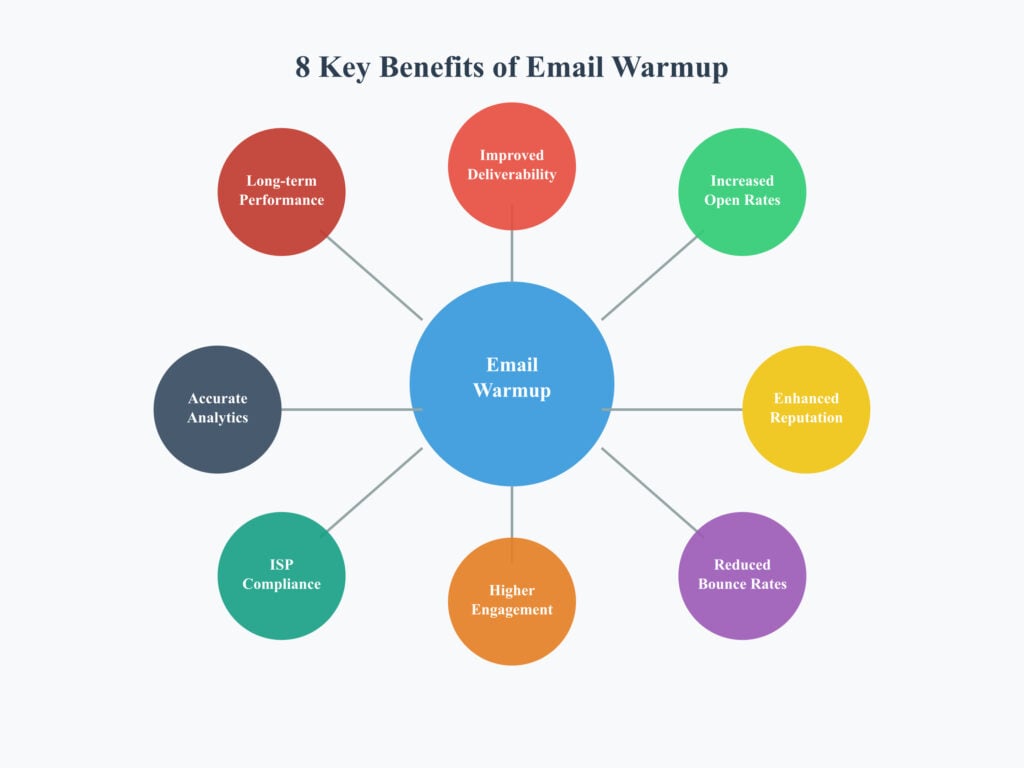
What is an email warmup service—and why do you need one?
An email deliverability tool sends and receives warmup emails on your behalf. It gradually increases the email volume and frequency while also replying to your emails.
It’s all done on autopilot, so you don’t have to lift a finger.
Warming up your email manually is both tedious and time-consuming.
Instead, a warmup service automates the entire process. This saves you time and allows you to focus on higher-value tasks, such as creating personalized outreach, analyzing campaign results, or closing important deals.
A warmup service typically handles:
- Sending automated warmup emails at scheduled times
- Opening the emails
- And replying to them from other accounts in their network
Some email warmup tools offer advanced deliverability features like personalized warmup emails and custom deliverability alerts.
Following an email warmup schedule
A warmup schedule ensures your email volume goes up steadily until you’re at the desired sending capacity without hurting your sender reputation.
By increasing it slowly, you can gain trust from internet service providers, build your sender reputation, and land in your audience’s inbox.
The optimal time to warm up an email address is one month, around 3 to 5 weeks.
Due to the ever-tightening antispam regulations, we now recommend not to send out more than 40 emails/day per email account (I don’t send more than 30 in my own outreach!) and 120 emails/day across the entire sending domain. This number includes both warmup and outreach emails.
Taking the above into account, you can keep your warmup schedule simple:
- Day one: 1 email/day
- Day two: 2 emails/day
- Day three: 3 emails/day
Until you reach 20 warmup emails/day (on day 20). That leaves room for 20 outreach emails/day for this email account.
Once you reach 20 warmup emails, keep the warmup going and wait for another 7 days or so before starting your outreach.
Our tip: during the initial warmup phase, try not to send outreach campaigns at all. If you decide otherwise, we recommend starting with a low volume and slowly ramping up each week.
Need a higher outreach volume?
20 outreach emails per day might not cut it for you. To send more, you must use multiple (warmed-up) email accounts.
But how can you use multiple email accounts for the same campaign?
Use Inbox Rotation, a lemlist feature that allows you to send hundreds of outreach emails without worrying about your email accounts getting blocked.
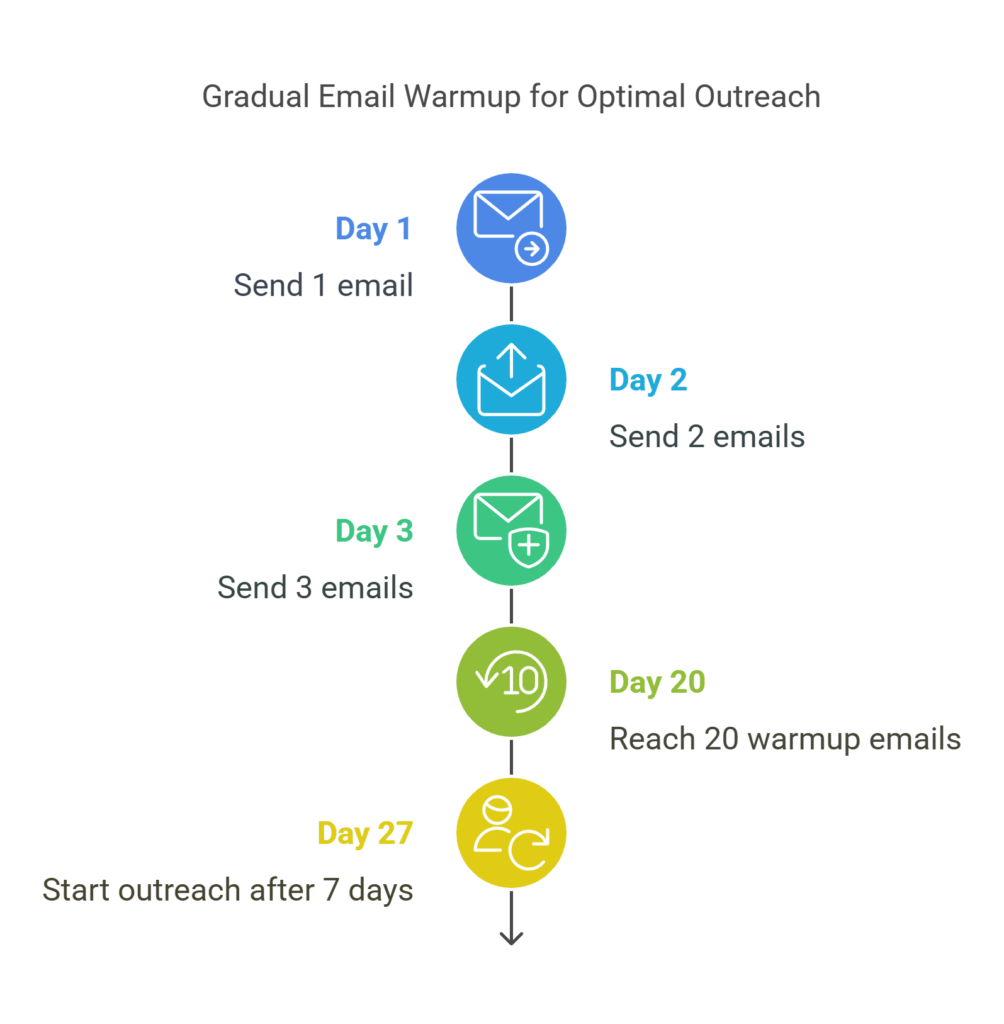
Can you warm up your email manually?
Warming up your email without a warmup service is possible, but it’s an arduous job.
Unlike a warmup service that handles everything for you, manual warmup requires you to manage the entire process yourself.
To warm up your email manually, you must:
- Follow a warmup schedule
- Write and send warmup emails
- Ensure that >50% of your emails get replies
As discussed in the next section, you can never stop the email warm-up process. You must keep it going at all times to continue enjoying superior engagement for your emails. Doing all that manually isn’t a scalable way to avoid spam folders.
Ongoing warm-up is essential for successful email outreach
Most people think they can stop the warm-up process after warming up their email. This is a newbie mistake.
You should always have a warm-up process running behind the scenes.
Why?
Since you’re doing email outreach, the engagement you get for your emails may be lower than with regular email. This dip in engagement can hurt your deliverability.
By keeping the warmup process going, you can ensure a healthy number of replies* to your emails and keep your sender reputation up, leading to higher open rates and more conversions.
* A healthy reply rate for email outreach = >10%. However, just getting replies isn’t enough; you’ll also want to receive positive replies. Keep it above 1%, and you’ll be fine. 1-5% is excellent.
Email authentication: An essential step before email warmup
Email authentication adds an extra layer of security to your emails, which results in better open rates.
You implement email authentication by adding specific DNS records to your domain’s DNS settings.
The three main email authentication protocols used today are:
- SPF: Ensures only authorized sending servers can send email from your domain
- DKIM: Protects your emails from being tampered with during transit
- DMARC: Determines what to do with emails that fail authentication
This three-piece super combo is making email a safer communication channel.
Best of all?
It’s yet another opportunity to distance yourself from some of your competitors.
With your emails more secure, internet service providers will give you better inbox placement, leading to more revenue generated for your business.
Needless to say, you must have these authentication records in place before starting warmup.
By clicking on each authentication protocol in the list above, you can explore step-by-step instructions on how to set them up effectively.
Email warmup tools
To efficiently warm up your email, you need a warmup service.
A simple Google search for email warmup service will result in many companies vying for your attention.
Unfortunately, many warmup tools use bad practices like sending emails to fake email addresses or using cookie-cutter warmup emails.
Sometimes, it gets so bad that the warmup service actually harms your sender reputation!
Case in point, just look at this horror story:

To help you avoid unpleasant scenarios like the one above, we’ve listed three reputable warmup services below:
lemwarm

lemwarm is the original email warmup service. It appeared on the market before all other warmup tools.
Praised for its personalized warmup emails and network tailored to the user’s industry, lemwarm is lemlist’s deliverability booster.
Apart from warming up your email, it also keeps track of your sender score and alerts you if deliverability issues arise.
Pricing:
- Essential plan: Standard warmup features from $24/month (free with a lemlist subscription)
- Smart plan: Advanced warmup and deliverability features from $40/month
Warmup Inbox

Warmup service with fewer advanced features than lemwarm, but cheaper priced.
For $19/month, you can send 75 warmup emails per day.
Warmup Inbox offers three plans:
- Basic: 75 daily warmup emails – 25% replies – $19/month
- Pro: 250 daily warmup emails – 45% replies – $59/month
- Max: 1000 daily warmup emails – 65% replies – $99/month
Mailreach

Similarly to lemwarm, Mailreach also offers a spam tester to help you find out where your emails are landing.
Mailreach uses a usage-based pricing model. For instance, additional spam test credits are purchased separately and added to your monthly bill. You get 20 credits for free each month.
Pricing:
- Starts at $25 per mailbox/month
- Additional 80 spam test credits at $28/month
Your next steps after the warm-up
You warmed up your account. What’s next?
Three main things to remember:
- Keep your warm-up enabled even after you reach the desired delivery rate
- Increase the sending volume gradually
- Track your email deliverability (at all times!)
A key part of tracking your email deliverability (3) is keeping an eye on your email metrics.
Email deliverability metrics are vital for measuring the performance of email marketing campaigns.
Key metrics to monitor include:
- Delivery rate: Measures how many emails successfully reach the receiving server
- Deliverability rate: Indicates the percentage of emails that bypass filters to land in the inbox
Important: Tracking open and click-through rates now hurts your deliverability. Email service providers want to keep their users away from promotional emails. By including tracking pixels in your emails, ESPs immediately know they’re dealing with commercial emails.
Additionally, you want to monitor and analyze these parameters:
- Spam rate: Assesses the volume of messages marked as spam
- Spam complaints rate: Indicates the percentage of emails reported as spam by recipients
- Soft bounce rate: Reflects temporary delivery issues (e.g., full inbox)
- Hard bounce rate: Represents permanent delivery failures (e.g., invalid email address)
These metrics collectively provide insights into your email deliverability and how effective your emails’ content is.
Time to start your email outreach
After you have successfully warmed up your email, you are ready for outreach.
It’s time to launch your campaigns.
To send out campaigns in a scalable way, you need a cold outreach tool.
The sales engagement platform lemlist stands out by offering a solution to sending human-like emails at scale.
With the help of artificial intelligence (AI), you can create personalized outreach sequences that drive replies.
lemwarm: A reliable email warmup tool
lemwarm is a warmup tool and deliverability booster that can significantly increase your open rates.
In fact, once you switch to a long-term lemwarm strategy, it’s possible to start hitting 80% open rates.
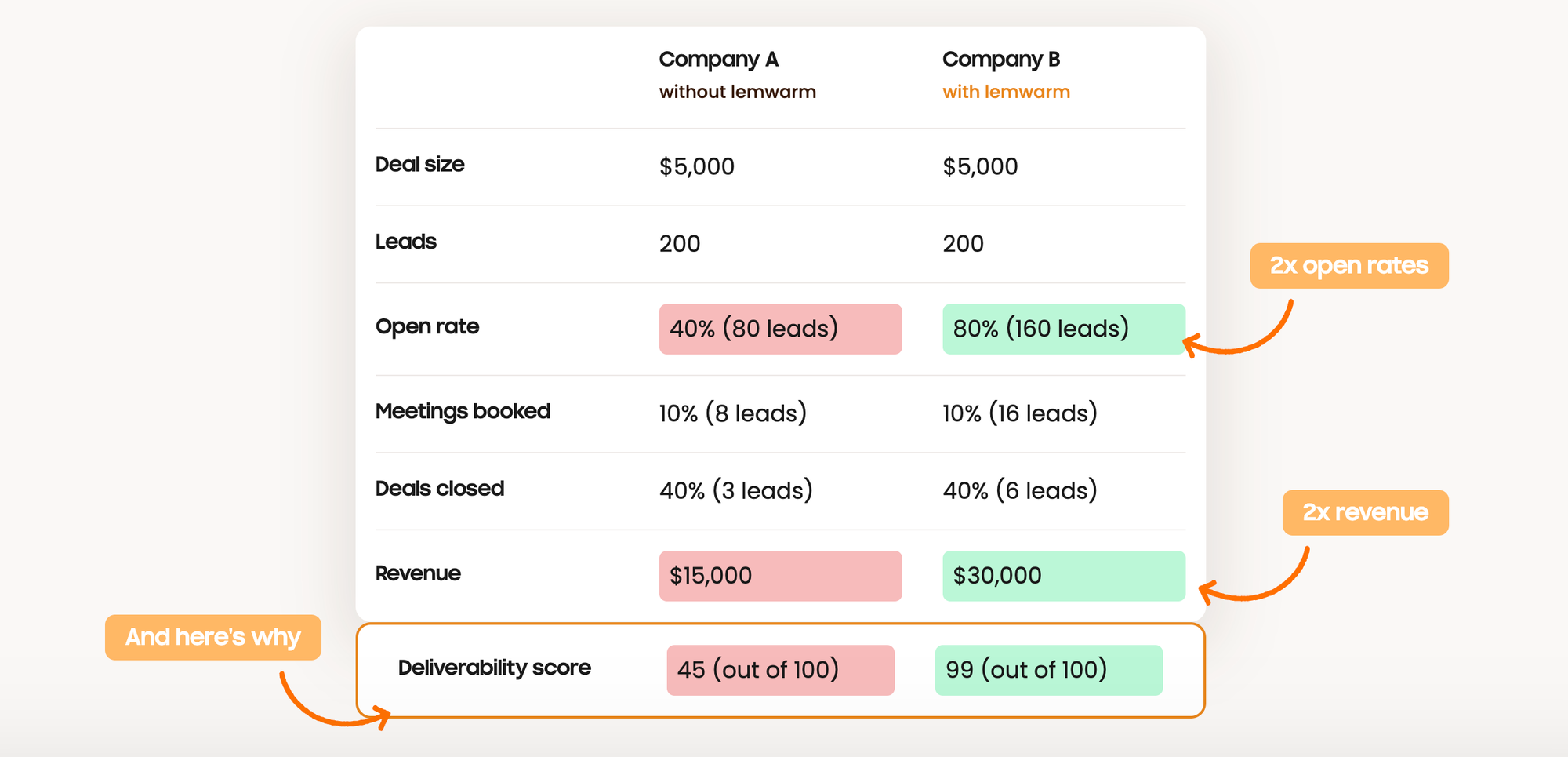
The lemwarm idea started thanks to our users. One day, Vaibhav opened up about a critical topic in the lemlist family community.
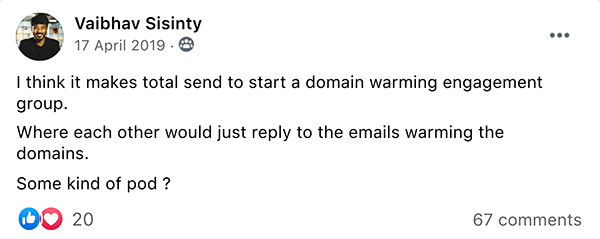
This is how lemwarm was born.
We stopped what we were doing at the time, joined the conversation, and decided to build one of the most important products for our community.
How does lemwarm work?
lemwarm sends unique warmup emails between its users from 100+ countries. This ensures that all interactions occur between real human email accounts.
Unlike some other warmup services, lemwarm doesn’t allow fake email addresses to join as they ruin our email domains. Instead, you’ll be exchanging emails with real people, including those from companies like Zendesk, Meero, Malt, Adeco, SAP, Uber, and more.
Our smart content algorithm generates each message and subject line, ensuring your emails look human-like.
Why is this important?
Because email providers will check and evaluate your messages. Human-like emails build trust with internet service providers, which is why lemwarm can double your email deliverability.
Here’s why lemwarm stands out
- lemwarm’s complex, proprietary algorithm, which operates on 100+ different parameters
- real people with verified emails and no fake accounts in the network
- 20K+ users worldwide
- 25+ years domain range
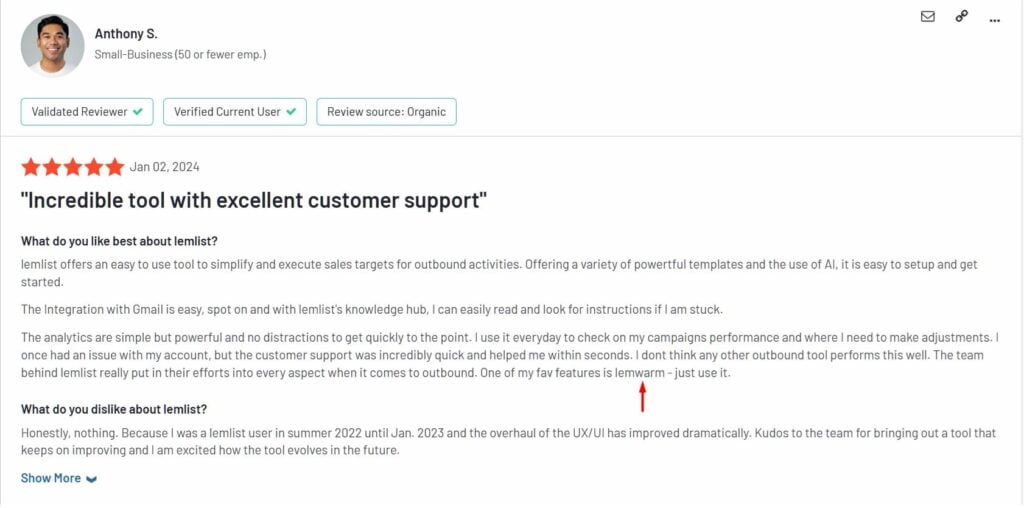
Key takeaways
Plan to warm up your email?
Always keep the following in mind:
- Email warmup significantly impacts your sender reputation and email deliverability as it boosts the chances of your emails landing in the inbox
- When choosing an email warm-up tool, ensure it uses real accounts from actual people, employs reliable algorithms, and follows trusted sending practices
- An email warm-up tool has to stay on at all times to protect your sender’s reputation
Email warmup is an excellent start toward optimal inbox placement. But there are more things to take care of. Fortunately, we’ll show you all the steps to avoid spam. Simply go through our checklist to improve email deliverability.
Frequently asked questions
How many emails should I send out per day to start?
For a brand-new email address, start with one email on the first day. Then, increase by one email each day until you reach 15-20 daily warm-up emails.
What is an email warmup strategy?
An email warmup strategy is the method by which you gradually build up your sender reputation. A good strategy is to start small, focus on engagement, avoid spammy content, and use an email warmup service.
Do email warmup tools actually work?
The good ones do. Not only to help you potentially double your email deliverability, but also to make the process faster and easier. Warmup tools like lemwarm play a massive role in the overall success of your email outreach.
What is the best email warm-up tool?
lemwarm offers advanced warm-up and deliverability features like warming up your own templates and getting alerts when deliverability issues threaten to derail your email outreach. It lets you focus on high-value tasks with the peace of mind of knowing that your email deliverability is in good hands.
Is buying an email domain a bad idea?
Yes, unless you do your research. Some domains come with a bad reputation, as one lemwarm user discovered when their new domain sent half of their emails to spam during warm-up. After investigating, we found the domain had been sold 27 times since 2011 and was previously used by spammers. Always check a domain’s history before purchasing.
SEO content writer helping B2B brands grow - Working remotely from sunny Costa Rica


